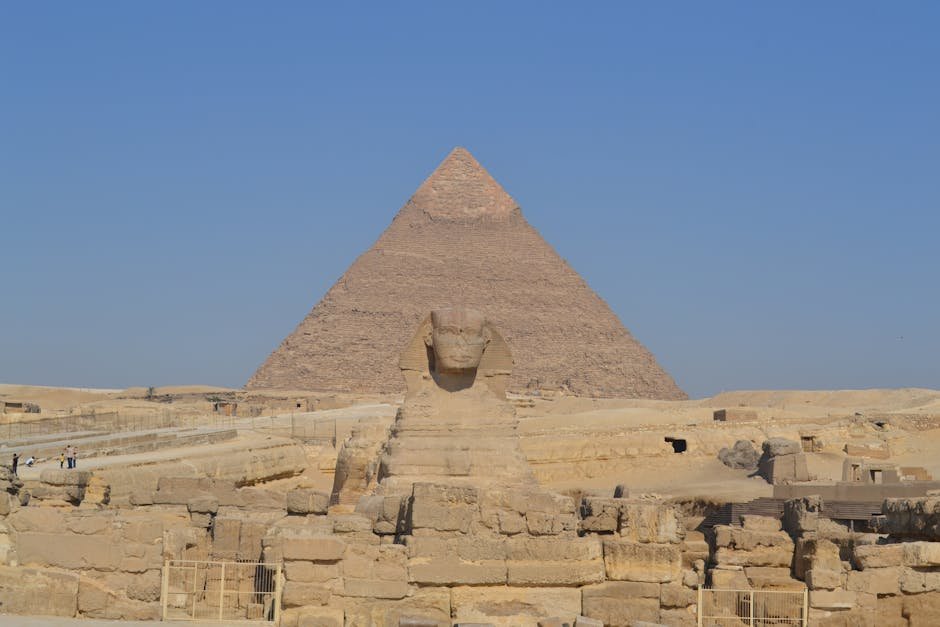King Khafre comes to life every time the sun casts golden hues upon the mighty stones of the second pyramid of Giza, where there rests the legacy of King Khafre, who is an enigmatic ruler whose reign echoes through eternity. Khafre, the son of the legendary Pharaoh Khufu, shaped his place in history as the creator of timeless wonders that seem to defy both man and nature.
Towering beneath the sun’s radiant gaze stands his pyramid, a colossal monument that reaches toward the heavens, second only to his father’s in size and splendor. Yet perhaps the most mystical of all is the Great Sphinx, carved from limestone, silently watching over Khafre’s pyramid with a gaze that holds the wisdom and mysteries of an ancient world. Khafre’s reign was one of transformation and artistic magnificence, blending divine authority with architectural mastery.
In the whispers of the wind and the shadows of the desert, the essence of Khafre lives on, immortalized in stone and spirit. His name, etched into history and the dreams of his people, carries the magic of a pharaoh who sought not just to rule, but to ascend, his legacy shimmering in the sands, as eternal as the stars above Egypt’s ancient kingdom.
Learn of the Incredible History of King Khafre
King Khafre, also known as Chephren, was an influential ruler of ancient Egypt’s Old Kingdom (2686-2150 BC), ascending to the throne around 2558 BC to 2532 BC as the fourth king of the Fourth Dynasty. His name means “The Appearing of Ra”. He was the son of the legendary Pharaoh Khufu, builder of the Great Pyramid, and succeeded his elder brother, Djedefre, to rule Egypt during a period marked by monumental achievements in architecture, art, and royal power consolidation.
Khafre’s legacy is predominantly tied to his grand architectural contributions at Giza, including his pyramid complex and the enigmatic Great Sphinx, believed by most Egyptologists to have been constructed under his reign. Despite the grandeur of his monuments, ancient Greek historians like Herodotus and Diodorus depicted Khafre as a harsh ruler, though these accounts contrast with Egyptological evidence suggesting stability and artistic flourishing during his reign.
Discover the Family Tree of King Chephren
King Khafre’s family tree is intricately connected to the prominent rulers of Egypt’s Fourth Dynasty. He was the son of King Khufu and possibly Queen Meritites I or Queen Henutsen. His succession followed that of his brother Djedefre, who took the throne briefly after Khufu’s death. Khafre married multiple queens, including Meresankh III, Khamerernebty I, and Hekenuhedjet, producing a large royal lineage. His main wife was Queen Mereceankh and he had 12 sons and 3 daughters.
His sons included Menkaure, who would later succeed him as pharaoh, as well as prominent princes such as Nebemakhet and Duaenre. The royal bloodline extended through his daughters, like Shepsetkau, who solidified alliances through strategic marriages. This extensive family network allowed Khafre to maintain a strong dynastic presence in Egypt, linking him to a legacy of rulers who shaped the era’s cultural and architectural advancements.
What Makes the Reign of King Khafre Legendary
King Khafre’s reign, which lasted approximately 24 to 26 years, was a defining period in Egypt’s Old Kingdom history. Despite discrepancies in historical sources with the ancient historian Manetho suggesting a 66-year rule, most scholars agree on a shorter duration. The absence of precise records on the Turin King List and other sources complicates the exact dating, but a carved inscription on the tomb of Khafre’s son, Nekure, suggests a rule of just over two decades.
Khafre’s time as pharaoh was marked by stability, architectural innovation, and grand construction projects, including his pyramid and temple complexes at Giza. These achievements emphasized the pharaoh’s divine role, while his political alliances and strategic marriages strengthened his dynasty’s influence.
Shed Light On the Accomplishments King Khafre
King Khafre’s accomplishments stand as testaments to the splendor of the Old Kingdom. He constructed the Pyramid of Khafre, the second-tallest pyramid at Giza, renowned for its well-preserved outer casing that glimmers in the sunlight. Additionally, the Great Sphinx of Giza, a colossal limestone statue believed to represent Khafre himself, was likely carved during his reign as a symbol of royal power and guardian of the necropolis.
Khafre’s architectural contributions extended to complex mortuary and valley temples, with stunning statues that have survived through the millennia. These accomplishments reflect not only his vision but also his era’s unparalleled craftsmanship, making his reign one of the most distinguished in ancient Egypt’s monumental history.
Explore the Death and Tomb of King Khafre
King Khafre died around 2532 BC, though the circumstances of his death remain unknown. His burial took place within his grand pyramid at Giza, a structure celebrated for its enduring legacy and architectural ingenuity. Khafre’s pyramid complex includes a mortuary temple, where rituals were performed to honor the pharaoh, and a valley temple containing statues of the king that highlight the sophisticated artistry of his reign.
His final resting place was guarded by the Great Sphinx, further amplifying the grandeur of his tomb. The entire complex underscores the significance placed on the afterlife in Egyptian culture, designed to ensure Khafre’s eternal protection and status among the gods.









